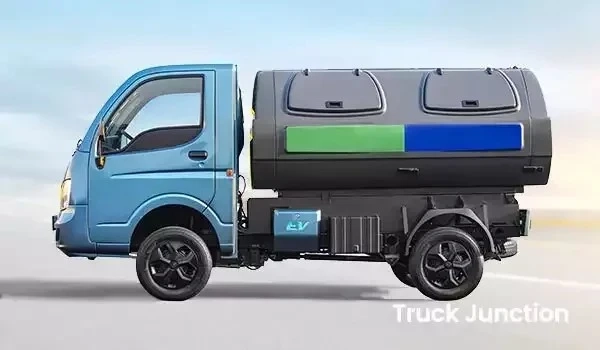The evolution of electric vehicles in the Indian transportation industry has been a journey with many up-downs and the industry has witnessed many challenges, developments, and policy interventions. Furthermore, various factors, such as concerns for the environment, advanced technology, and government initiatives, have shaped the growth and acceptance of EVs in India over the past few years.
As a result of these factors and a long enchanting journey, the Indian Automobile Industry now has several models of electric vehicles from different brands available in the market. Regarding cargo transportation, although there are several options available in the market. Tata Ace EV is among the top models.
Early Beginnings:
The concept of electric vehicles is trackable, back to the early 20th century in India. Electric rickshaws and battery-powered cycles were among the first electric vehicles to hit Indian roads. However, that time's limited range and battery technology restricted their widespread adoption.
A modernised electric vehicle with advanced technology features is a great deal. Moreover, Electric vehicles are beneficial for the environment and are more cost-effective. Tata Ace EV Price ranges between Rs. 9.21 Lakh and Rs. 9.22 Lakh.
Growth of Two-Wheelers:
In the late 20th century, two-wheeler electric vehicles gained popularity due to their low operating costs and eco-friendly image. In addition, companies like Hero Electric, Bajaj, and TVS introduced electric scooters and motorcycles, which found appeal among urban commuters seeking an economical and green mode of transportation.
Challenges and Slow Progress:
Despite initial enthusiasm, the growth of EVs in India faced several challenges. Moreover, the need for charging infrastructure, high upfront costs, limited range, and a mindset favouring conventional internal combustion engine (ICE) vehicles hindered the mass adoption of electric vehicles.
Government Initiatives:
In the early 2000s, the Indian government acknowledged the potential of Electric vehicles and introduced several policies and incentives to promote the adoption of EVs in daily life. As per the reports, the National Electric Mobility Mission Plan (NEMMP) 2020 aimed to attain 6-7 million sales of hybrid as well as electric vehicles by 2020. Besides, subsidies, tax benefits, and research grants were introduced to encourage manufacturers and consumers to embrace EVs.
Entry of International Players:
International automakers began to enter the Indian EV market, bringing advanced technology and expertise. Furthermore, companies like Mahindra Electric, Tata Motors, and Nissan introduced electric models, contributing to the diversification of electric vehicles in the country.
Shift Towards E-Rickshaws:
E-rickshaws emerged as a game-changer in the Indian EV market. These affordable and environment-friendly vehicles provided a last-mile connectivity solution for many cities, especially in congested areas with limited traditional public transport.
Government's FAME Scheme:
In 2015, the Indian government launched a scheme called the Faster Adoption and Manufacturing of (Hybrid &) Electric Vehicles (FAME) scheme to promote the adoption of EVs and set up charging infrastructure. Moreover, under FAME-I and FAME-II, financial incentives were offered to manufacturers and buyers, further encouraging the production and purchase of EVs.
EV Charging Infrastructure:
One of the critical challenges for EV adoption was the need for charging infrastructure. However, the situation began to improve with the government's focus on creating a robust charging network and private players investing in charging stations. Hence, charging stations started to be established in major cities and along highways.
Growth of Electric Buses:
With a focus on sustainable public transportation, electric buses gained traction in various cities. Initiatives like the Delhi government's 'Switch Delhi' campaign aimed to encourage the adoption of electric buses in public transport fleets.
Electric Mobility Startups:
The rise of electric mobility startups in India added momentum to the EV revolution. Companies like Ather Energy, Revolt Motors, and Ola Electric introduced innovative electric scooters and motorcycles, leveraging technology to address range anxiety and improve performance.
Policy Thrust and Targets:
The Indian government continued to push for EV adoption with ambitious targets. India announced plans to electrify 30% of all road vehicles by 2030, focusing strongly on electric two-wheelers and three-wheelers.
Local Manufacturing and R&D:
Mainly, the Make in India initiative encouraged indigenous manufacturing of EVs and their components. Indian companies started investing in research and development to develop homegrown electric vehicle technologies.
Global Partnerships:
Indian automakers collaborated with international companies to leverage global EV technology and accelerate the development of EVs in India. Partnerships were forged to share knowledge and resources and promote electric mobility solutions.
Transition to EVs in Public Fleets:
State governments and municipal corporations started transitioning their public vehicle fleets to electric. Besides, electric taxis and auto-rickshaws became common sights in several cities.
Focus on Green Mobility:
The push towards green mobility and increasing awareness of environmental issues prompted individuals and businesses to consider electric vehicles a viable alternative to ICE vehicles.
Future Outlook:
As per the reports, the future of electric vehicles in India looks promising. Additionally, the industry is witnessing continuous growth with new models, improved technology, and expanding charging infrastructure. Government policies, incentives, and collaborative efforts between the private and public sectors are driving the electrification of transportation.
Conclusion
In conclusion, the evolution of electric vehicles in the Indian transportation industry has been a journey of progress, overcoming challenges, and embracing sustainability. Moreover, with an increasing focus on eco-friendly solutions, technological advances, and supportive government policies, the future of EVs in India appears bright as the nation strives for a cleaner and greener mobility ecosystem. However, developments in the EV sector are continuously evolving.


